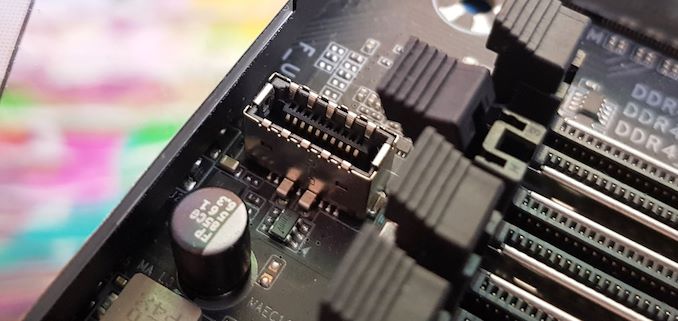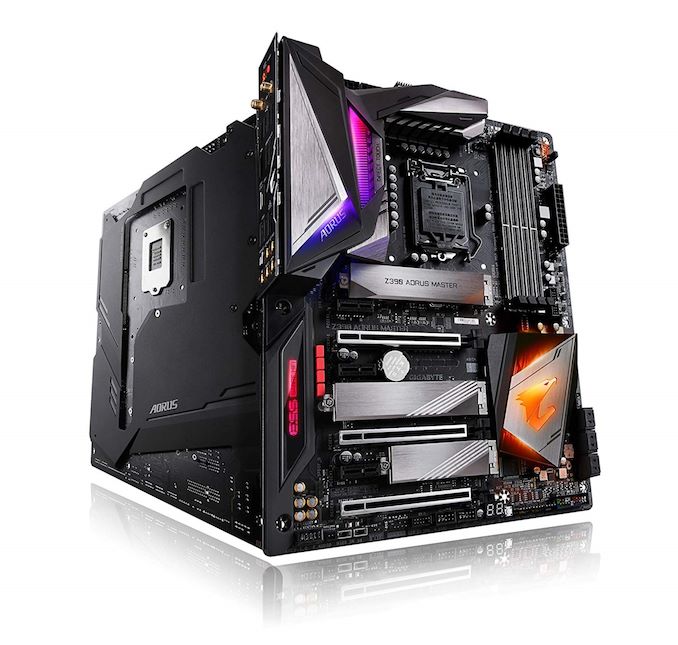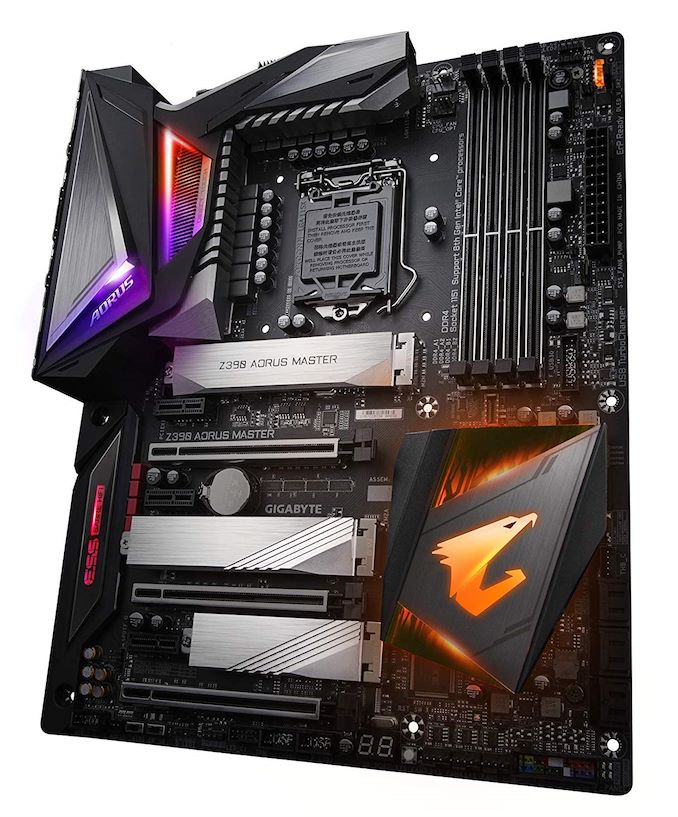The GIGABYTE Z390 Aorus Master Motherboard Review: Solid, But Not Special
by Gavin Bonshor on March 21, 2019 12:30 PM EST- Posted in
- Motherboards
- Intel
- Gigabyte
- ATX
- LGA1151
- i7-8700K
- Z390
- Aorus Master
The $250 to $300 motherboard competition stack is highly contested for Z390, with GIGABYTE, ASRock, MSI, and ASUS all having at least two models each in this segment. Some manufacturers add in 2.5 or 10 GbE NICs into its models in this price range, or extensive USB 3.1 G2 offerings, and it forces the manufacturers to step up. GIGABYTE brings the ATX sized Z390 Aorus Master to the table and while it is an attractive model with plenty of features such as triple M.2 with three individual M.2 heatsinks to use and a pre-attached rear IO shield, GIGABYTE could have equipped the Z390 Aorus Master with a little more.
The performance in our test suite as far as system and CPU testing went proved that the Z390 Aorus Master can hang with the competition in most instances, however there were a few slips, perhaps due to its memory training not being as tight as the competition at stock settings. There were some slightly disappointing results with a mediocre showing in our DPC Latency testing and the results in our game testing seemed to be a couple of percent off the expected mark. For computational tasks, however, the Z390 Aorus Master did well and in our power consumption tests, it seemed quite efficient given our power hungry i7-8700K testbed sample. The performance in our non-UEFI POST time test was also good and competes well against some of the best performers. In our overclocking tests, we did hit a few snags along the way which we generally don't experience. We managed a maximum stable overclock of 5.0 GHz at 1.3 V on the CPU VCore which is good for our Core i7-8700K, but it couldn't go beyond this. To achieve it we had to change a whole host of power related settings as we got crashes at what are usually successful combinations of CPU frequency and CPU Core Voltage. To alleviate the unreliable CPU VCore readings from the CPU-Z utility and GIGABYTE's own EasyTune software, users can download HWINFO and use the VR VOUT reading under the IR35201 section of the utility.
On the rear panel, GIGABYTE does include a total of four USB 3.1 G2 ports (three Type-A, one Type-C), two USB 3.1 G1 compatible with its USB DAC-UP 2 technology and four USB 2.0 ports. Users looking for more can use the front panel headers which include one USB 3.1 G1 Type-A header (two ports), two USB 2.0 headers (four ports) and a single USB 3.1 G2 Type-C header. While the additional Type-C header is welcomed, its placement does seem a little lacklustre given it’s so close to the clasp of the second RAM slot. With the header populated, it would need to be unplugged to remove an installed stick in that slot. Something slightly more disappointing is the Intel I219-V 1 GbE PHY and considering the $290 price tag, I would expect to see a little more in this area; perhaps a 2.5 or 5 GbE NIC to help cement the Z390 Aorus Master as a premium model. There is an Intel 9560 802.11ac MU-MIMO Wi-Fi adapter present which uses the CNVi within the Z390 chipset and it offers users Bluetooth V5 connectivity. Also featured on the rear panel is a handily located clear CMOS button and users can power and reset their system by using the dedicated power switch on the rear.

The clasp of RAM slot two obstructing front panel USB 3.1 G2 Type-C Header
GIGABYTE in previous years has opted to focus a lot of its attention on the audio and the Z390 Aorus Master is no exception to this. The board utilizes the premium Realtek ALC1220 HD audio codec and even includes an ESS Sabre 9118 DAC which features its own integrated headphone amplifier. Users with USB headsets can also use the two USB DAC-UP 2 ports on the rear with the supplied software. This allows users to apply voltage compensation to pump a bit more juice through the cable, although this shouldn’t be too much an issue unless the headset cable is extensively long. Covering the audio PCB is a fancy looking plastic cover, but it doesn’t double up as an EMI shield. On the PCB is five gold audio capacitors and four WIMA capacitors. The only issue is the lack of a dedicated third-party software suite which we’ve seen over the years. Even though the Realtek Audio Console is decent, even giving users some extra software such as the Creative or another alternative would go a long way to giving the user a more premium feel to bolster their overall experience.
Conclusion
With a price tag of $290 its extravagant looks, its solid feature set with a Realtek ALC1220 audio codec, Intel 9560 802.11ac MU-MIMO Wi-Fi and solid power delivery with one of the heatsinks on the Z390 chipset make it attractive. There could be some more focus put on the premium components, but GIGABYTE seemingly put its focus on the onboard audio which they are well known for doing and everything else seems to be on par with the competition. The metal rear PCB brace is a nice touch and expands somewhat upon the premium feature set on offer, but it's not defining aspect to make it the defining board of its price point.
Ultimately, the Z390 Aorus Master is a solidly product, and when overclocked should make a user very happy when going above stock performance, particularly in memory. However, GIGABYTE should trying to stand out from the competition with at least one super feature.












36 Comments
View All Comments
spaceweasel - Monday, May 27, 2019 - link
Solid 5.0Ghz at 38C, at idle, on my Aorus Master, with F8 BIOS. One of the best motherboards I have ever used.3dfx_Rampage - Friday, March 22, 2019 - link
And yet a bottom of the barrel Asus board performed better. More phases does not automatically make a VRM better.shaolin95 - Thursday, April 4, 2019 - link
hahahahaha BS...Asus you can cook on it but that is how butthurt Asus fanboys are. CAnt accept that on z390, Asus dropped the ball big timeOpencg - Wednesday, March 27, 2019 - link
for all those phases it sure comes out alot slower than the asus boardsCyruskain - Thursday, March 21, 2019 - link
"During the overclock testing on the Z390 Aorus Master, we had to take a slightly different approach due to some instability as we went through the multipliers with default power settings."Yes, yes, and yes. I bought this board back in November on Black Friday due to a great sale New Egg had on it (which surprises me that this review is as late as it is. This board is about 5 months old now). But I simply couldn't figure out how to overclock the CPU manually via BIOS on this board due to crashing loops. I ultimately settled on using the Appcenter EZTune software which placed my 9700k @ 5.1 and ~1.3v, although it fluctuates depending on load (of course). I'm happy enough with a software generated 5.1. But OCing this board shouldn't have been as annoying as it was.
I'm actually surprised it was near bottom of the barrel for gaming fps though. Bummer. But I like the Mobo all things considered, especially the amount of USB ports it has.
Oh, and it does have a solid VRM as El Sama stated.
gavbon - Thursday, March 21, 2019 - link
I'm currently testing the GIGABYTE Z390 Aorus Pro WIFI (on the test bench) and the overclocking is pretty similar in experience. As I highlighted in the review, this board (and the Pro WIFI) are the only boards where I've had to adjust LLC and power settings to achieve 5-5.1 GHz.Cyruskain - Thursday, March 21, 2019 - link
@gavbon I'm going to attempt to mirror the BIOS changes you did and see where that nets me. I also attempted to adjust the LLC alongside the freq. multiplier, but I continued to get crashing loops. However, there were things from the article you did that I didn't, so I'm curious to try it out. But, at the end of the day, the software netting me 5.1 isn't anything to scoff at. It's pretty impressive for software.gavbon - Thursday, March 21, 2019 - link
At least the software gave you a stable overclock, to begin with! 5.1 GHz is certainly good, pretty awesome if you ask me!sonny73n - Friday, March 22, 2019 - link
You can OC GPU with software but I would recommend against OCing CPU with software, especially Gigabyte software. Google it!ZedVile - Thursday, March 21, 2019 - link
I have done a bit of testing on this Motherboard both on the test bench and fully integrated into a build. Ring ratio seems to play a role with performance and defaults have changed through-out the bios revisions. Huge variations in performance, CPU voltage requirements and ring ratio defaults.Bios F6 defaulted the Ring ratio to 4.8 while later revisions have lowered the ratio to 4.7 and 4.6.
I have experienced the best bench performance with the 9900k on F6 BIOS ring ratio 4.8 and at 5.0GHZ all core at 1.285 Volts. B-die at 4266 1.5v
Passes Intel Burn Test very high and maximum. 5.2GHZ @ 1.375 also passes IBT very high on F6 bios.
On the contrary bios F8e requires 1.325v @5.0GHZ and does not pass IBT @ maximum. Performance is also down if the ring ratio is not manually adjusted back up to 48.
Buildzoid has a great vid on samsung B-die overclocking on the Z390 Master
Over on the Gigabyte forum users have complained about XMP profiles and RAM compatibility throughout the bios revisions...
@Gavin Which bios revision were you using, and did you test DPC latency & gaming perf with different bios revisions?